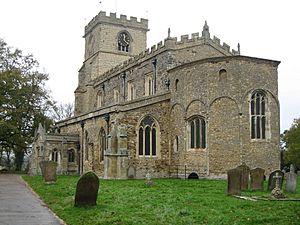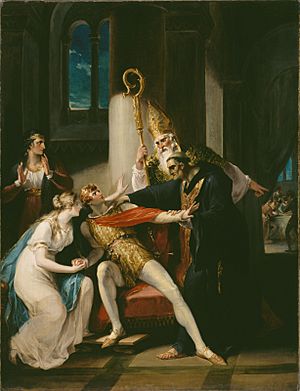Ælfgifu (wife of Eadwig) facts for kids
Quick facts for kids Ælfgifu |
|
|---|---|
| Queen consort of the English | |
| Tenure | c. 955 – 958 |
| Burial | Winchester Cathedral |
| Spouse | Eadwig, King of the English (annulled) |
| Father | Uncertain |
| Mother | Æthelgifu |
Ælfgifu was a queen of the English. She was married to King Eadwig of England from about 955 to 958. Their marriage was later ended, or annulled.
Not much is known about Ælfgifu. Most information comes from old documents called Anglo-Saxon charters. Some details also come from the Anglo-Saxon Chronicle and stories written by monks. These stories were sometimes not kind to her. Her marriage to King Eadwig caused problems. It was a target for political groups who wanted power in the 950s.
Later in her life, around the 960s, Ælfgifu became a wealthy landowner. She had a good relationship with King Edgar, Eadwig's brother. She left a will that gave many gifts to churches. These included the Old Minster and New Minster in Winchester.
Contents
Who Was Ælfgifu's Family?
We know two main things about Ælfgifu's family. First, her mother was named Æthelgifu. She was from a very important family. Second, Ælfgifu was related to her husband, King Eadwig. In 958, their marriage was ended by Archbishop Oda. This was because they were too closely related by blood.
Historians have used these clues to guess Ælfgifu's family background. Both ideas suggest she was from a royal family. One idea is that she was a noblewoman from Mercia. She might have been related to a powerful leader named Æthelfrith of Mercia. This idea comes from a place called Risborough. It was one of Ælfgifu's properties mentioned in her will. This land might have belonged to Æthelfrith's family before her.
Another idea comes from her will too. In this document, she mentions Ælfweard and Æthelweard. They seem to be her brothers. Æthelweard might be the famous historian who wrote a Latin chronicle. This historian claimed to be a descendant of King Æthelred of Wessex. If this is true, Ælfgifu would also be related to King Æthelred. This would make her Eadwig's third cousin.
These two family ideas are not impossible to combine. It's possible that Ælfgifu's parents came from these two different royal family branches. However, these ideas are not fully proven. They depend on whether the Ælfgifu who wrote the will is the same person as the queen. Most historians believe they are the same, but they are not completely sure.
Why Was Her Marriage Controversial?
King Eadwig married Ælfgifu when he was young. This marriage became very controversial in 10th-century England. Eadwig's brother, Edgar, was the next in line for the throne. If Eadwig and Ælfgifu had a son, that son would have a strong claim to be king. This would make it harder for Edgar to become king.
Edgar had strong support from powerful families in Mercia and East Anglia. These families would not want to lose their power. They would not want Ælfgifu's family to become more powerful. Some historians think the marriage might have been a way for Eadwig to gain political power in Mercia.
Ælfgifu's mother, Æthelgifu, seemed to be important in her rise. They appear together in old records. They both witnessed a land exchange document. Their names are also listed as important givers to the New Minster in Winchester. In her will, Ælfgifu asked a bishop to pray for her and her mother.
In 958, Archbishop Oda ended Eadwig and Ælfgifu's marriage. He said they were too closely related. But the real reason was probably political. Ending the marriage helped Edgar's chances of becoming king. It's likely that Edgar's supporters, like Dunstan, pushed for this.
This event was part of a bigger struggle for power. In 957, Edgar was chosen as king of Mercia. Some stories say this was a revolt against Eadwig. They say Eadwig lost control of northern England. But this might be an exaggeration. Eadwig still called himself "king of the English." Even so, Eadwig's position was weak.
Not all church leaders were against Ælfgifu. Æthelwold, a powerful abbot and later bishop, seemed to support her. Ælfgifu's name is on a document that confirms a land exchange involving Æthelwold. In this document, she is called the king's wife. Her will also shows her close connection to Æthelwold.
Ælfgifu's Later Life

After her marriage ended, Ælfgifu's life changed. King Eadwig died in 959. His brother Edgar then became king of all England. Some old stories say Ælfgifu was sent away. But these stories are not always reliable.
Evidence suggests that by the mid-960s, Ælfgifu was doing well. She had peace and wealth. She also had a good relationship with King Edgar and the royal family. This is because she is believed to be the same Ælfgifu who was a rich landowner. She was called "a certain noble matron" by King Edgar in two royal documents from 966. He also said she was related to him by blood.
Before King Edgar died in 975, Ælfgifu left a will. In it, she gave away many lands and valuable items. These gifts went to:
- Churches like Old Minster, New Minster, Abingdon Abbey, Romsey Abbey, and Bath Abbey.
- Bishop Æthelwold.
- Members of the royal family, including King Edgar, Queen Ælfthryth, and Edward the Martyr.
- Her close family, like her two brothers, her sister, and her brother's wife.
Her biggest gifts went to King Edgar and the Old Minster. She gave the Old Minster a large estate called Princes Risborough. Her will does not mention any children. Her high status is shown by a gift to King Edgar. It included valuable armlets, a drinking cup, horses, shields, and spears.
It is strongly believed that the two Ælfgifus (the queen and the wealthy landowner) are the same person. This is because of their close ties to the royal family, Bishop Æthelwold, the New Minster, and their mothers.
We don't know exactly how Ælfgifu became wealthy again. Some of her lands were given to her by King Edgar. Others might have been inherited or bought. For example, Princes Risborough might have come from her mother's family. If she owned many of these lands, it means her return to wealth was important. It also greatly increased the royal family's land.
King Edgar showed kindness to Ælfgifu in 966. He recognized their family connection. Some historians wonder if he was pressured to do so. King Edgar named his third son, Æthelred, after Ælfgifu's ancestor. This might have been a friendly gesture to show their kinship.
In her will, Ælfgifu linked her gifts to churches with the salvation of her soul and Edgar's soul. This suggests she supported the Benedictine reform. King Edgar was a big supporter of this reform. Bishop Æthelwold was a key leader. Ælfgifu likely hoped her gifts would be used for good. For example, a place called Marsworth was given to Ely Abbey by Bishop Æthelwold.
Ælfgifu's will also helped to strengthen ties between her family and the royal family. She asked King Edgar to protect her men who sought his help. She also made sure that some lands would first be leased by her siblings. They would pay a yearly rent to the Old and New Minsters. After their lives, the lands would go to the Old Minster.
King Eadwig was buried in the New Minster. But Ælfgifu wanted to be buried in the nearby Old Minster. At Winchester, Ælfgifu was remembered for her generosity. Her mother, Æthelgifu, was also remembered. Their names appear in an old book from the New Minster as important benefactresses.
WHO RECEIVED THE GIFT WHAT WAS GIVEN Churches: Old Minster, Winchester Land at Princes Risborough (Bucks.), except for freed slaves. + 200 gold coins (mancuses), her special shrine with holy items. + Lands at Mongewell (Oxon.) and Berkhampstead (Herts.), see below. New Minster, Winchester Land at Bledlow (Bucks.). + 100 gold coins (mancuses). Nunnaminster (St Mary's Abbey), Winchester A paten (a plate used in church). Nunnery of Christ and St Mary at Romsey (Hants.) Land at Whaddon (Bucks.). Abingdon Abbey Chesham (Bucks.). Bath Abbey Wickham (possibly in Berkshire or Hampshire, but hard to identify). Royal Family King Edgar Lands at Wing (Bucks.), Linslade (Bucks.), Haversham (Bucks.), Hatfield (Herts.?), Marsworth (Bucks.) and Gussage (Dorset). + 2 armlets (each worth 120 mancuses), a drinking cup, 6 horses, 6 shields, and 6 spears (her "death-duty" to the king). The ætheling (prince), probably Edward Land at Newnham Murren (Oxon.), given earlier by King Edgar. + An armlet worth 30 mancuses. Queen (Ælfthryth) A necklace worth 120 mancuses, an armlet worth 30 mancuses, and a drinking cup. Family Ælfweard, Æthelweard, and Ælfwaru (her siblings) Lands at Mongewell (Oxon.) and Berkhampstead (Herts.) for their lives. They had to pay a yearly food-rent to the Old and New Minster. After they died, the lands would go to the Old Minster. Ælfwaru "All that I have lent her." Ælfweard A drinking cup. Æthelweard An ornamented drinking horn. Æthelflæd, her brother's wife A headband. Bishops and Abbots Bishop Æthelwold Land at Tæafersceat (location unknown). She asked him to pray for her and her mother. Each abbot (of the churches she gave to) 5 pounds of pence to fix their church. Bishop Æthelwold and Æthelgar, abbot of the New Minster Remaining money was given to them. It was for (1) taking care of the Old Minster and (2) giving to the poor.
See Also





